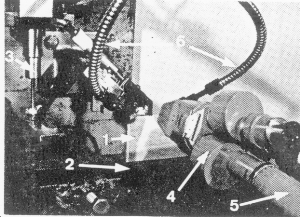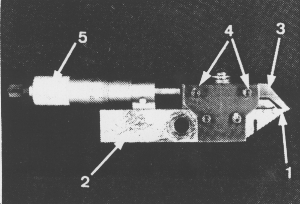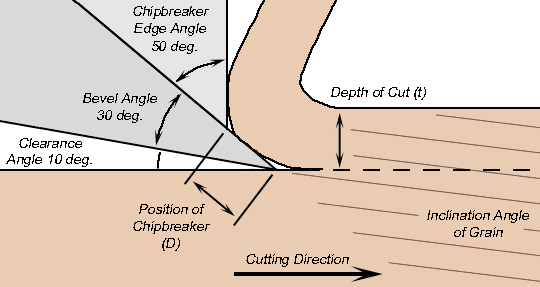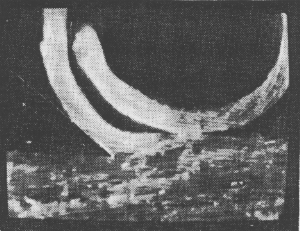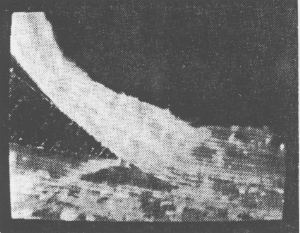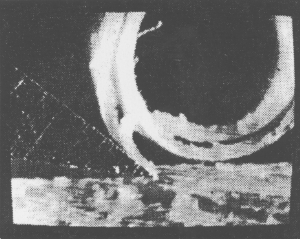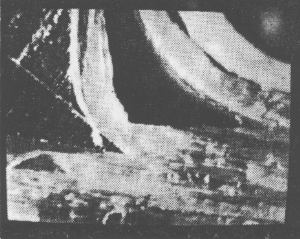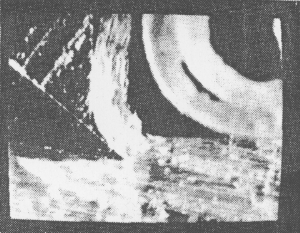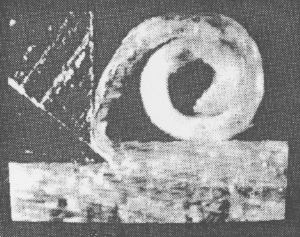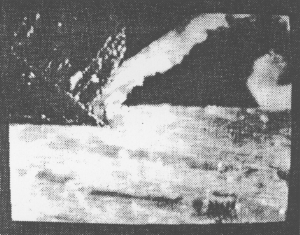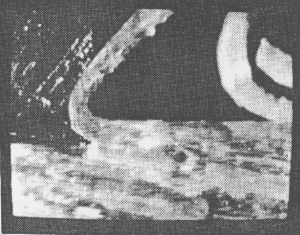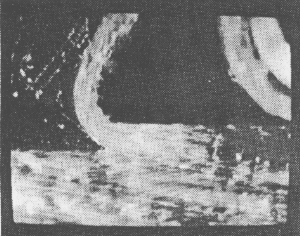|
|
|
Effect of Knife Chipbreakers on Surface Finish by Professor Chutaro Kato, Yamagata University Yamagata, Japan Abstract A video was made to show how a chipbreaker (cap-iron) functions during orthogonal cutting of wood. A video tape of the cutting action was made using a microscope and video camera. The cutting action is almost the same as that produced by a Japanese hand plane except for the very low cutting speed. The tool angle [i.e. the bevel angle of the blade] is 30 degrees. The clearance angle is 10 degrees. The edge angle of the chipbreaker is either 50 or 80 degrees. The depth of cut is either 0.05 mm or 0.1 mm (.002 or 004 inches). The inclination angle of grain to the cutting direction is either +7 or -7 degrees. The negative number of the inclination means that cutting is against grain, which results in a high probability of chipped or torn grains. This video shows exactly how the chipbreaker prevents the generation of the chipped or torn grains in cutting against the grain.
Introduction Wooden studs with a 5 in x 5 in cross section are frequently used in the construction of typical Japanese houses. The faces of the studs are exposed on both the inside and outside of the rooms in the house. The surfaces are usually finished by cutting with hand planes, are exceptionally smooth, and are kept natural without paint. A wooden stud whose surfaces are not coated with paint adjusts to the humidity inside a room so well that an individual can live comfortably. In order to get the fine surfaces, Japanese-type hand planes are used by carpenters. Recently, a woodworking machine which has the same cutting principle as a hand plane was designed. This machine is called a super-surfacer in Japan. Super-surfacers have replaced the hand planes to reduce the labor intensive nature of the finishing process. Surfacers have a very sharp cutting knife that produces exceptionally thin chips, less than 0.1 mm (.004 inches). The wood cells must be cut cleanly without crushing them in order to get the fine surface finish. Japanese middle school curricula have technology as one of the required subjects, which includes woodworking. A hand plane is used as a teaching tool for making some small wooden products such as a book shelf. This video was made for the purpose of helping persons, including middle school students, understand wood cutting principles so that they can master woodworking technology efficiently.
Procedure for Taking the Video: This video demonstrates how a chipbreaker (cap-iron) functions during orthogonal cutting of wood. A video tape of the cutting action was made using a microscope and video camera system as shown in Figs. 1 to 3. The cutting knife was fixed to the vertical axis of a plain milling machine (Fig. 1). The workpiece was set on the table feeding slowly at a fixed speed. The depth of cut was set by adjusting the height of the table. The knife consisted of a tool and a chipbreaker (Fig. 2). The position of the chipbreaker was adjusted by turning a micrometer screw until its edge came to one of the predetermined position marks. The position marks were made on the rake face of the tool with Vickers micro-hardness tester at the distances of 0.1 mm, 0.2 mm, and 0.3 mm (.004, .008 and .012 inches) from the tool cutting edge (Fig. 3).
Fig. 1: Video camera and microscope system. Notes: 1: workpiece, 2: table of milling machine, 3: displacement meter, 4: microscope, 5: video camera, 6: lights
Fig. 2: Cutting knife and micrometer adjustment. Notes: 1: tool, 2: tool holder, 3: chipbreaker (cap-iron), 4: screws to make chipbreaker edge parallel to the tool edge, 5: micrometer for adjusting chipbreaker position.
Cutting Condition The cutting action is as shown in Fig. 3. The tool angle (wedge angle) is 30 degrees and the clearance angle is 10 degrees. The edge angle of the chipbreaker is either 50 or 80 degrees. The depth of cut is either 0.05 mm or 0.1 mm (.002 or .004 inches). The inclination angle of grain to cutting direction is either +7 or -7 degrees. The negative inclination angle means that cutting is against grain. This produces a high probability that chipped or torn grains will occur.
Fig. 3: Cutting action Notes: Chipbreaker Edge Angle: 50 and 80 degrees, Angle of Grain: +7 degrees (cutting with grain) and -7 degrees (cutting against grain), Position of Chipbreaker (D): 0.1, 0.2 and 0.3 mm (.004, .008, and .012 inches), Depth of Cut (t): 0.05 and 0.1 mm (.002 and .004 inches), Cutting speed: 0.4 mm/second. Wood species: Hoonoki (Magnolia obovata Thunb.), moisture content: 10 %, specific gravity: 0.45
Sample Pictures The nine combinations of cutting conditions were recorded on the video camera system and are shown in Fig. 4 to Fig. 12.
Fig. 4: The knife without a chipbreaker is cutting wood with the grain. The depth of cut is 0.1 mm (.004 inches). This cutting condition produces a good surface finish.
Fig. 5: The knife without a chipbreaker is cutting wood against the grain. The depth of cut is 0.1 mm (.004 inches). The chip forms by cleavage failure which extends into the workpiece and below the plane generated by the path of the cutting edge. As the result, this type of failure produces a machining defect commonly called chipped or torn grain.
Fig. 6: The knife without a chipbreaker is cutting the wood against grain. Chipped grains are not generated and surface finish is good. Only the depth of cut is now changed from 0.1 mm (.004”) to 0.05 mm(.002”).
Fig. 7: The knife with a chipbreaker is cutting wood against grain. The depth of cut is 0.1 mm (004”). The chipbreaker is set at the furthest position of 0.3 mm (.012”) from the cutting edge and has an edge angle of 50 degrees. When the chip is sliding along the chipbreaker face, frictional forces must be generated between chip and chipbreaker, which tends to reduce the amount of cleavage fracture. However, the action is still not good enough to eliminate chipped or torn grain completely.
Fig. 8: A chipbreaker with an edge angle of 50 degrees is set at the position of 0.2 mm (.008”) from the cutting edge of the knife. The depth of cut is 0.1 mm (.004”). The effect of the chipbreaker is to reduce the occurrence of chipped and torn grain considerably.
Fig. 9: A chipbreaker with an edge angle of 50 degrees is set at the closest position of 0.1 mm (.004”) from the knife cutting edge. The depth of cut is 0.1 mm (.004”). Initially the chip thickness varies but then stabilizes after a short time. Neither chipped nor torn grains occur. The surface finish is good.
Fig. 10: The edge angle of the chipbreaker is changed to 80 degrees, which is the largest used. The chipbreaker is set at the position of 0.1 mm (.004”). The depth of cut is 0.1 mm (.004”). Neither chipped nor torn grains occur. Deformation of the chip, however, extends below the plane generated by the path of the cutting edge. The chipbreaker position is too close to the knife cutting edge. The surface finish is good.
Fig. 11: The chipbreaker is set at 0.2 mm (.008”), which is the mid-position from the knife edge. The chipbreaker has an edge angle of 80 degrees. The depth of cut is 0.1 mm (.004”). The chipbreaker is working well. Chipped grain is not produced and surface finish is good.
Fig. 12: The chipbreaker is set at 0.3 mm (.012”), which is the farthest position from the knife edge. Deformation of the chip against the chipbreaker is reduced and serious cleavage failure of the chip does not occur. The surface finish is good.
Conclusions
|
|
[Home] [Summary of Results] [Testing Procedure] [Chipbreaking] [Chipbreaker Tests] [Chipbreaker Study] [A Controlled Test] [Review of Cap Iron Study] [Cap Iron Study by Kees van der Heiden] [Mechanics of Chipbreakers] [Cutting Angles] [Shaving Formation] [Tuning Infill Planes] [Links & References] [Contact] [Site Map] |
